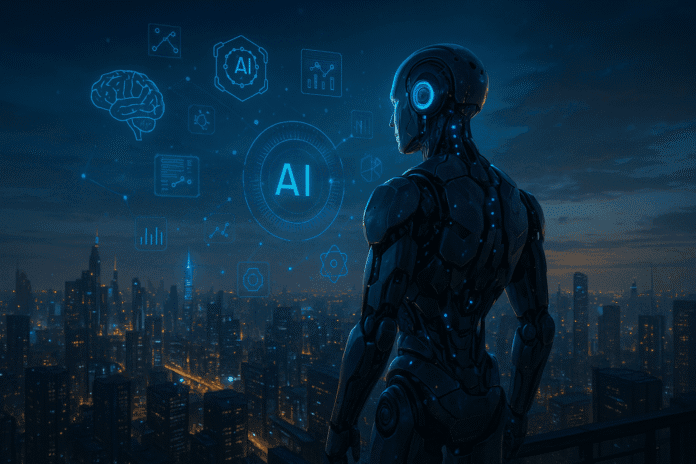Artificial General Intelligence (AGI) has long been a dream for scientists, technologists, and visionaries around the world. In 2025, we are witnessing stunning breakthroughs that are redefining what’s possible in the field of AI. Unlike narrow artificial intelligence that excels at specific tasks, AGI possesses the remarkable ability to reason, learn, and understand in ways that closely resemble the human mind. This game-changing technology is set to transform every corner of our lives—sometimes in ways we never expected.
As AGI evolves at an unprecedented pace, industries like healthcare, education, and business are already feeling the impact. From autonomous creativity to real-world problem solving, the advances we’re seeing in 2025 are nothing short of breathtaking. But with great power comes great responsibility. As AGI becomes more capable, important questions about safety, ethics, and trust come sharply into focus.
In this article, we’ll dive deep into 10 stunning Artificial General Intelligence breakthroughs that are shaping the year 2025. You’ll learn how AGI is not only pushing the boundaries of technology, but also forcing us to rethink the relationship between humans and machines. Whether you’re a tech enthusiast, a business leader, or simply curious about the future, these innovations are sure to surprise and inspire you.
Contents
The Current State of Artificial General Intelligence
Artificial General Intelligence (AGI) stands as one of humanity’s boldest technological frontiers. While artificial intelligence in various forms is already a part of daily life—from voice assistants to smart recommendations—AGI represents a leap far beyond today’s narrow, task-specific systems. Instead, AGI aims to mimic the broad, adaptable intelligence of humans, enabling it to learn, reason, and solve unfamiliar problems without needing explicit programming for each scenario.
Definition and Key Concepts
AGI refers to a type of AI capable of understanding, learning, and applying knowledge across a wide range of tasks, much like a human. It’s not restricted by pre-programmed boundaries and can transfer knowledge from one domain to another, which is a significant departure from traditional AI models. This adaptability is what sets AGI apart and makes it such a compelling goal for researchers worldwide.
Milestones Up to 2025
The journey toward AGI has been marked by a series of milestones. In recent years, language models have made headlines with their ability to generate human-like text and engage in deep conversation. Major leaps in machine learning algorithms, increased computing power, and vast data availability have pushed the field forward. By 2025, AGI systems are beginning to exhibit forms of reasoning and creativity once thought to be uniquely human. They can analyze complex scenarios, provide innovative solutions, and even explain their thought processes in ways people can understand.
Major Players and Innovators
The push for AGI isn’t happening in isolation. Leading tech giants like Google, Microsoft, and OpenAI, as well as ambitious startups and university research teams, are all contributing to the rapid progress in this field. Collaborative initiatives and open-source projects have democratized access to AGI tools, allowing a global network of innovators to accelerate the pace of discovery. The result is a vibrant ecosystem where breakthroughs can come from anywhere in the world.
AGI vs. Narrow AI: Key Differences
Understanding the difference between AGI and narrow AI is crucial. Narrow AI excels at specific tasks—it can drive a car, recommend a movie, or recognize a face—but it can’t generalize its knowledge to new, unrelated domains. AGI, in contrast, learns continuously and adapts to unfamiliar situations. For example, an AGI that learns to play chess could also apply its reasoning skills to managing a supply chain or diagnosing a medical issue. This generalization is what makes AGI both powerful and, to some, a source of caution.
As of 2025, AGI is not a single technology, but a dynamic and rapidly evolving field. Its development is shaped by advances in neuroscience, robotics, ethics, and computer science, making it a truly multidisciplinary pursuit. The world is watching closely as AGI matures, eager to see how it will reshape society, industry, and the very nature of intelligence itself.
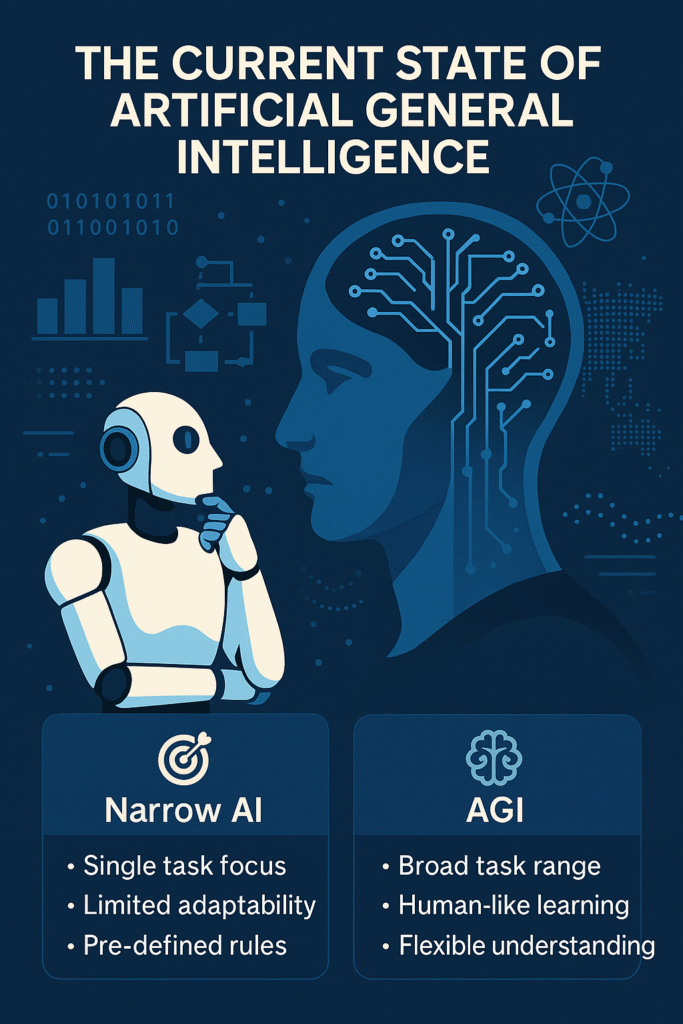
AGI vs. Narrow AI
| Feature | Narrow AI | AGI |
|---|---|---|
| Task Range | Single/few tasks | Multiple, diverse tasks |
| Adaptability | Low | High |
| Learning Ability | Limited | Continuous, generalizable |
| Human-like Reasoning | No | Yes |
| Example | Virtual assistant | Future AGI system |
Key AGI Milestones (up to 2025)
| Year | Milestone |
|---|---|
| 2016 | Deep reinforcement learning advances |
| 2020 | GPT-3 launches, language breakthrough |
| 2023 | Multimodal AI integration |
| 2024 | Human-level reasoning emerges |
| 2025 | Autonomous creativity in AGI |
2025’s Most Stunning AGI Breakthroughs
The year 2025 stands as a defining moment in the history of Artificial General Intelligence. No longer confined to research labs or theoretical discussions, AGI is now making waves in real-world applications, impressing experts and everyday people alike. In this section, we’ll explore the most stunning breakthroughs of AGI that are shaping the present and rewriting what we thought was possible.
Human-Level Reasoning and Understanding
Perhaps the most thrilling leap in AGI is its ability to reason and understand at a level that rivals human cognition. Unlike narrow AI, which only excels at specific tasks, AGI in 2025 demonstrates not only logical thinking but also the power to interpret ambiguous data, make sense of new concepts, and even apply ethical reasoning. Today’s AGI can debate moral dilemmas, offer expert advice, and adapt its approach based on context—skills that were once thought to be exclusively human.
Real-World Problem Solving
Gone are the days when AGI was limited to simulations or controlled environments. In 2025, advanced AGI systems are deployed for high-stakes, real-world challenges. Whether it’s coordinating global supply chains during emergencies, optimizing energy grids, or supporting disaster response teams, AGI processes massive streams of data and synthesizes solutions faster than any human team. The result: smarter decisions, less waste, and lives saved.
Autonomous Creativity in AGI
Creativity was once seen as a uniquely human trait, but in 2025, AGI is breaking that barrier. Modern AGI doesn’t just generate random outputs—it creates with purpose. AGI-designed drugs are reaching clinical trials in record time, while AI-generated artworks are selling for millions. From composing music to inventing sustainable materials, AGI is collaborating with—and sometimes even outperforming—human creators in ways few anticipated.
Massive Language Comprehension
Another astonishing breakthrough is AGI’s unparalleled mastery of language. Today’s AGI communicates fluently in dozens of languages, instantly analyzes complex texts, and even senses emotional undertones in conversations. Businesses are using AGI to break down communication barriers, while individuals benefit from real-time translation and personalized learning. This leap in language skills is opening new doors for education, diplomacy, and international cooperation.
These stunning breakthroughs are not only expanding what AGI can do, but they’re also challenging us to rethink the boundaries between human and machine. As 2025 unfolds, AGI’s capabilities will continue to grow, driving innovation and sparking important conversations about our shared future.

Key AGI Breakthroughs in 2025
| Breakthrough | Description |
|---|---|
| Human-Level Reasoning | Mimics human intuition and logical thinking |
| Real-World Problem Solving | Solves complex scenarios quickly and reliably |
| Autonomous Creativity | Produces art, inventions, and scientific solutions independently |
| Massive Language Comprehension | Understands and communicates in dozens of languages |
| Adaptive Decision-Making | Learns and improves in real-time situations |
Table 2: AGI’s Impact by Sector
| Sector | AGI Transformation Example |
|---|---|
| Healthcare | Rapid, accurate diagnoses; drug discovery |
| Education | Personalized learning paths; multilingual tutoring |
| Business | Process automation; strategy optimization |
| Science | Accelerated research; creative problem-solving |
| Arts & Media | Original digital art and content creation |
How AGI Is Transforming Daily Life
Artificial General Intelligence is no longer just a buzzword in the world of tech; it is actively reshaping how people live, learn, and work in 2025. Unlike previous waves of automation and machine learning, AGI has the capacity to understand, adapt, and solve a broad spectrum of problems in real time. This means that its impact is visible not only in advanced industries but also in the most routine parts of daily life. Let’s explore some of the most significant transformations driven by AGI today.
AI in Healthcare and Diagnosis
One of the most revolutionary changes is happening in the field of healthcare. AGI-powered systems are now assisting doctors with diagnoses, analyzing huge volumes of patient data, and predicting health risks with incredible accuracy. Patients are getting personalized treatment recommendations based on their genetic profiles and lifestyle choices. AGI even helps with early disease detection by spotting subtle patterns that human doctors might miss, leading to better outcomes and longer lives.
Revolutionizing Education
Education has become far more accessible and personalized thanks to AGI. Intelligent tutoring systems can adapt lessons on the fly, identify each student’s strengths and weaknesses, and provide tailored support that boosts confidence and motivation. Language barriers are disappearing, as AGI instantly translates lessons and conversations for students from around the globe. By 2025, every child can access a world-class education, no matter where they live.
AGI in Business & Industry
In the business world, AGI is unlocking new levels of productivity. It automates complex decision-making, forecasts market trends, manages logistics, and even negotiates contracts. This doesn’t just make companies more efficient; it also helps small businesses and entrepreneurs compete on a global scale. In factories, AGI-powered robots are handling dangerous tasks, while in offices, virtual AGI assistants schedule meetings and handle customer support.
Everyday Consumer Applications
AGI is now woven into everyday life in ways that would have seemed like science fiction just a few years ago. Smart homes anticipate your needs, managing everything from temperature to groceries. Personal finance is simpler and safer, with AGI monitoring accounts for fraud and optimizing investments. Even entertainment has changed—AGI curates playlists, suggests books and movies, and even creates personalized content.
AGI’s influence is making daily life smoother, more convenient, and often safer. But these advances also raise important questions about privacy, dependence, and the evolving relationship between humans and machines. As AGI becomes a trusted partner in so many aspects of life, society is learning to navigate both the rewards and the risks of this new era.
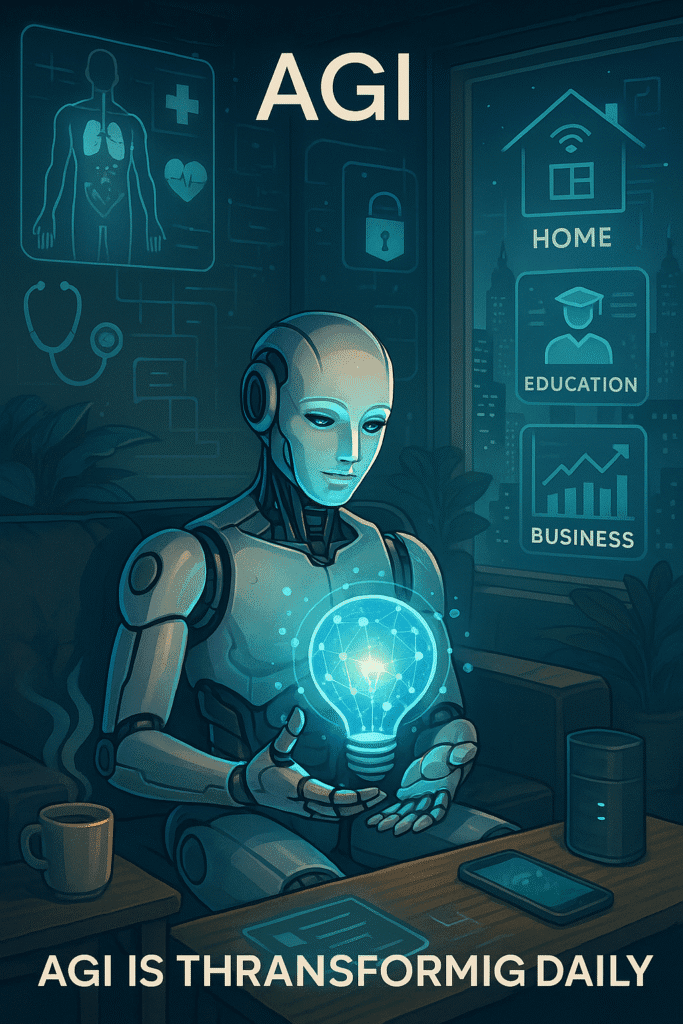
AGI in Everyday Life
| Domain | AGI Application Example |
|---|---|
| Healthcare | Early diagnosis, personalized medicine |
| Education | Adaptive tutoring, instant translation |
| Business | Automated logistics, predictive analytics |
| Home | Smart devices, proactive home management |
| Security | Real-time threat detection, fraud prevention |
Benefits and Challenges of AGI
| Benefit | Challenge |
|---|---|
| Improved convenience | Data privacy concerns |
| Enhanced decision-making | Over-reliance on automation |
| Personalized experiences | Job displacement risks |
| Faster problem-solving | Security and ethical dilemmas |
| Increased global access | Digital divide |
The Big Ethical and Security Questions
As Artificial General Intelligence continues to evolve and influence every part of society, the questions around ethics and security are no longer theoretical—they’re urgent and practical. In 2025, AGI is powerful enough to shape economies, influence politics, and even guide personal decisions. This immense power makes the responsible development and management of AGI a top priority for organizations and governments worldwide.
Responsible AGI Development
One of the main challenges is ensuring that AGI is designed with ethical standards from the ground up. Developers must decide whose values are encoded in AGI systems and how those values might affect people from different cultures or backgrounds. There is also the question of transparency: should AGI’s decision-making processes be fully open for scrutiny, or would that expose sensitive information and create new risks? In 2025, many organizations are adopting strict ethical guidelines and forming interdisciplinary review boards to oversee AGI projects.
AGI Safety Challenges
Safety is perhaps the most critical aspect of AGI’s continued advancement. With AGI’s ability to learn and act independently, there is always the risk that it could make decisions with unforeseen consequences. In 2025, one of the most-discussed topics is “alignment”: ensuring AGI’s goals remain in sync with human intentions and societal needs. Researchers are working on advanced safety mechanisms, including simulated environments for testing AGI and layered controls to prevent harmful actions. But as AGI becomes more autonomous, these challenges only grow more complex.
Societal Impacts and Concerns
The spread of AGI is raising deep questions about society’s future. Some worry about job losses as AGI automates more professions, while others see opportunities for humans to focus on creative and meaningful work. The influence of AGI on public opinion and democratic processes is another concern, as AGI-driven bots can spread misinformation or manipulate discourse at an unprecedented scale. In 2025, public debates about AGI’s role in society are common, and many governments are beginning to address the broader impacts of this technology through new laws and education.
Regulations and Governance in 2025
Regulation is still catching up with technology. Some countries have established strict AGI standards, requiring regular audits and ethical certifications, while others have taken a more hands-off approach. International bodies are starting to propose treaties and guidelines to prevent a dangerous AGI “arms race.” However, balancing innovation with safety and privacy remains a major challenge. The push for global standards reflects a shared understanding: the risks and rewards of AGI are simply too great for any one nation or company to handle alone.
The ethical and security challenges surrounding AGI will shape its future as much as the technology itself. The answers we choose today will determine whether AGI becomes a force for good, a source of division, or something in between.
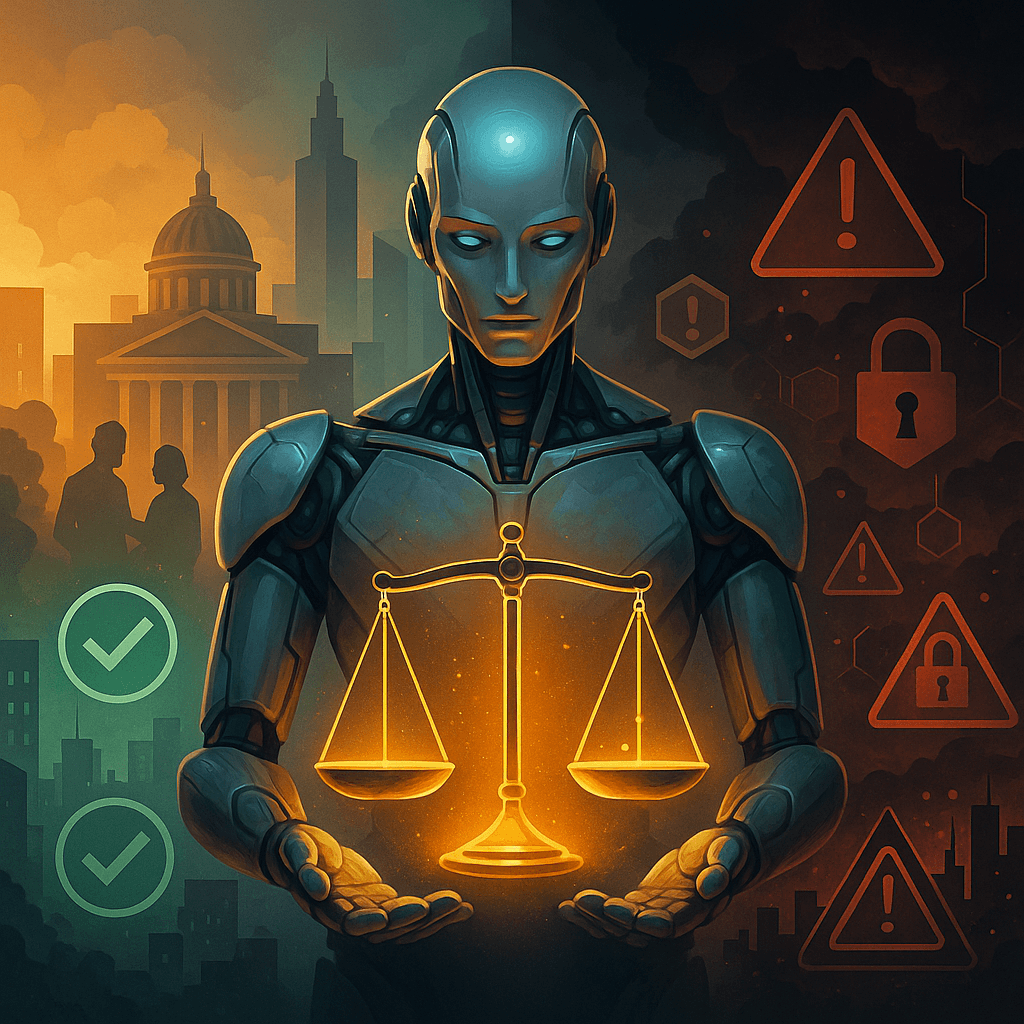
Major Ethical Questions in AGI
| Issue | Example Question |
|---|---|
| Value alignment | Whose ethics should AGI reflect? |
| Transparency | How open should AGI’s decisions be? |
| Accountability | Who is responsible for AGI’s actions? |
| Privacy | How is sensitive data protected? |
| Consent | Should people opt-in to AGI-driven decisions? |
Leading Security Strategies for AGI in 2025
| Strategy | Description |
|---|---|
| Alignment checks | Regularly testing AGI’s goals vs. human intent |
| Red-teaming | Simulated attacks to find vulnerabilities |
| Fail-safes | Automatic shutdowns if danger detected |
| Continuous monitoring | 24/7 oversight of AGI behaviors |
| Global cooperation | Sharing best practices and threat intelligence |
The Future of Artificial General Intelligence
As we look ahead from 2025, Artificial General Intelligence is not just an achievement—it’s a springboard into a future that will reshape humanity’s path. While AGI has already demonstrated stunning capabilities, experts agree that the coming years hold even more dramatic shifts and surprises.
Predictions from Industry Leaders
Futurists, scientists, and CEOs alike are projecting bold scenarios for AGI. Some see AGI as the backbone of scientific discovery, unlocking solutions for climate change, disease, and poverty. Others envision a world where AGI becomes a creative partner, collaborating with humans on everything from business strategy to fine art. A common thread in these predictions is acceleration: as AGI helps to design smarter systems and tools, progress itself speeds up—a phenomenon known as the “intelligence explosion.”
AGI’s Potential Limits
Despite rapid progress, many researchers are clear-eyed about AGI’s boundaries. There are philosophical and technical hurdles that may never be fully overcome. Can a machine truly “understand” the world, or is it simply mimicking understanding? Will AGI ever experience emotions or consciousness, or are these uniquely human traits? In 2025, these debates are far from settled. What’s certain is that every new AGI breakthrough reveals more about both machines and ourselves.
The Road to Superintelligence
Beyond AGI lies an even more transformative idea: artificial superintelligence (ASI). This is the hypothetical point where machine intelligence far surpasses that of any human. While some believe ASI could arrive within decades, others caution that it might take centuries—or may never come at all. Regardless, the path toward superintelligence is guiding ethical discussions, international policy, and safety research today. As AGI grows, so does the urgency of ensuring these systems align with human values and remain under meaningful control.
Building Trust with AGI
The future of AGI isn’t just a technical issue—it’s a matter of trust. For AGI to benefit society, people must feel confident in its fairness, safety, and transparency. In 2025, companies and governments are investing in “explainable AI,” clear communication about how AGI works, and open forums for public debate. Building this trust is a continuous process, involving regulation, oversight, and active engagement with the people whose lives AGI will impact.
Ultimately, the future of Artificial General Intelligence will be shaped not only by engineers and scientists, but by all of us. Our hopes, fears, and choices will determine whether AGI becomes a force for progress or a source of risk. As the story of AGI unfolds, humanity’s own story is being rewritten—together.
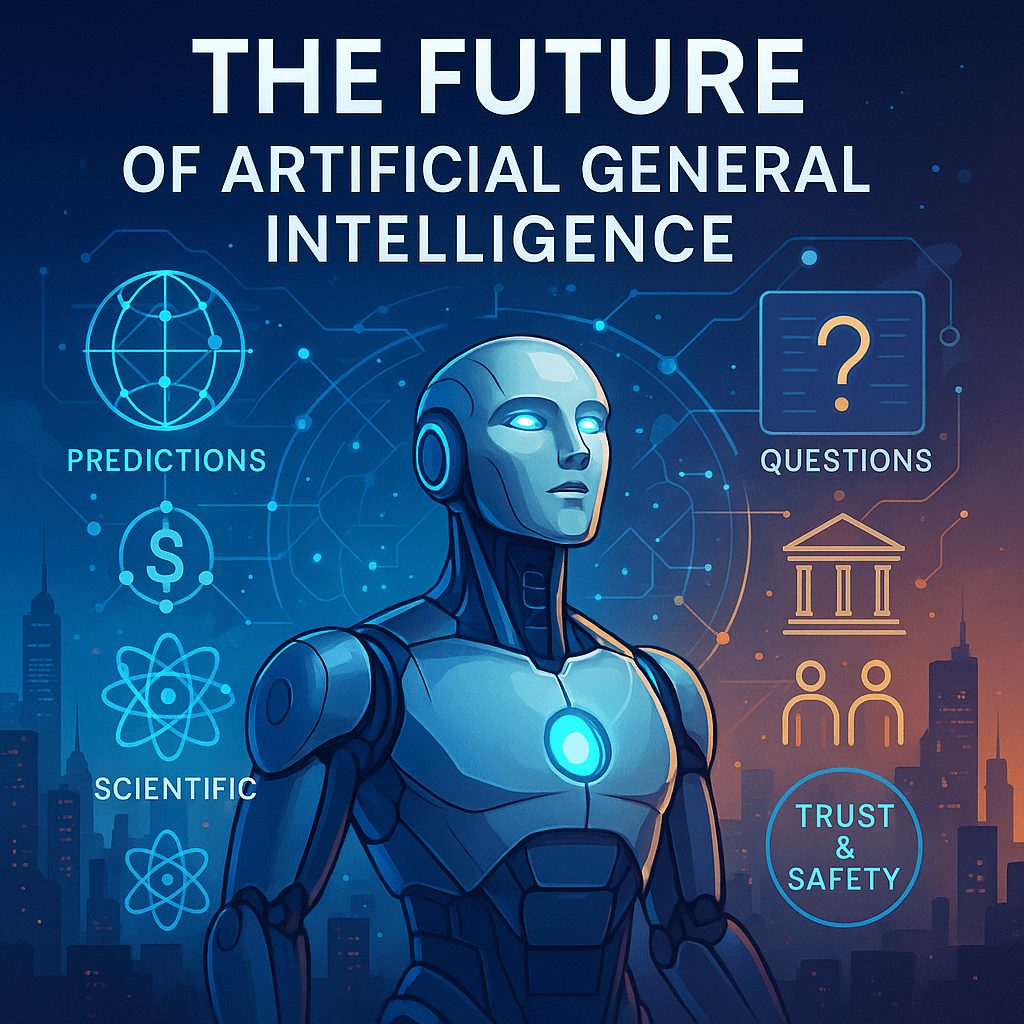
Leading AGI Predictions for the Future
| Prediction Type | Possible Scenario |
|---|---|
| Scientific | AGI accelerates medical and climate breakthroughs |
| Creative | Human–AGI collaborations produce new forms of art |
| Economic | Radical automation transforms industries |
| Social | AGI becomes a common advisor in everyday decisions |
| Ethical | Global agreements on AGI safety and fairness |
Ongoing Questions About AGI’s Future
| Question | Current Discussion |
|---|---|
| Can AGI become conscious? | Ongoing debate in philosophy |
| Will AGI ever truly replace humans? | Most believe partnership is key |
| How do we ensure AGI remains safe? | Regulation and global cooperation |
| Who is responsible for AGI’s actions? | Calls for new legal frameworks |
| Will AGI make life better for everyone? | Depends on access and governance |
Conclusion
Artificial General Intelligence in 2025 is not just a technological marvel—it’s a force reshaping the world around us. From healthcare and business to education and art, AGI’s impact is both profound and far-reaching. As we’ve explored, the most stunning breakthroughs of this year have turned science fiction into reality, demonstrating that AGI can learn, adapt, create, and solve problems on a level that rivals human intelligence.
But with great progress comes great responsibility. The ethical dilemmas and security concerns we face are as critical as the advances themselves. As AGI becomes more deeply woven into the fabric of society, our collective choices will determine its role in our lives—whether as a partner for progress or a challenge to navigate.
Looking forward, the future of Artificial General Intelligence is bright but uncertain. While predictions range from accelerating scientific discovery to the possibility of superintelligent machines, one thing is clear: trust, transparency, and global cooperation will be vital. By working together, we can ensure that AGI remains a tool for good, driving innovation while safeguarding humanity’s core values.
Artificial General Intelligence is no longer a distant vision. It’s here, shaping our present and defining our future. The journey has just begun, and its story is one we’ll all help to write.
Frequently Asked Questions (FAQs)
What is Artificial General Intelligence (AGI)?
Artificial General Intelligence is a form of AI that can understand, learn, and apply knowledge across a wide range of tasks, much like a human. Unlike narrow AI, AGI adapts to new situations without needing specific programming for each scenario.
How is AGI different from regular AI?
AGI can generalize knowledge and solve unfamiliar problems, while regular AI (narrow AI) is designed for specific tasks. AGI mimics human-level reasoning, learning, and creativity.
What are some real-world breakthroughs of AGI in 2025?
AGI now demonstrates human-level reasoning, solves complex real-world challenges, creates original art and solutions, and communicates fluently in multiple languages.
Is AGI safe for society?
AGI safety is a major focus in 2025. Developers use alignment checks, ethical review boards, and international regulations to make sure AGI remains beneficial and aligned with human values.
How is AGI transforming daily life?
AGI improves healthcare diagnoses, personalizes education, automates business processes, and makes smart homes safer and more convenient.
Will AGI replace human jobs?
While AGI automates some roles, it also creates new opportunities. Many experts believe AGI will work alongside humans, supporting creativity and strategic thinking.
